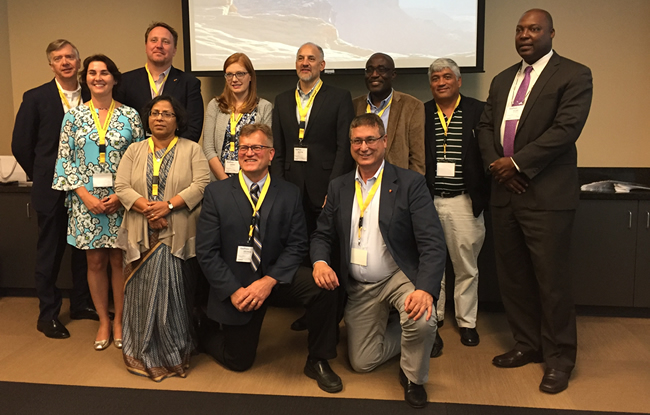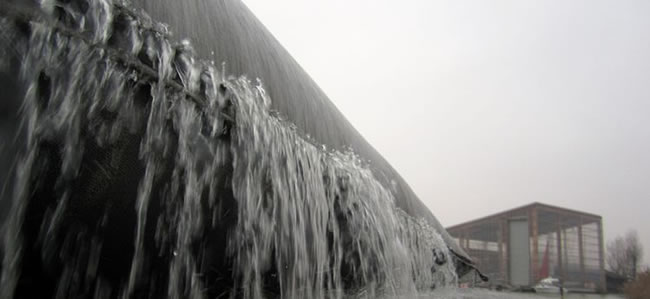On the heels of ASCE’s GeoCarolinas conference in Charlotte, North Carolina, locally headquartered HUESKER delivered a high-level technical seminar and networking event. The gathering GeoPASS II, followed the previous year’s format: a strong list of invited speakers for a day-long seminar, a diverse range of topics, a limited attendee list representing various perspectives and specialties in the field, and a manufacturing facility tour on the next morning.
The October 11 event included approximately 30 participants and was organized by HUESKER Head of Engineering, Lilma Schimmel. HUESKER CEO Sven Schröer joined Schimmel in welcoming the attendees and presenters and facilitated introductions.

THE GEOPASS II TECHNICAL SEMINAR
Speakers and topics for the event, in order of appearance, included:
- Shobha Bhatia (Syracuse University) – “Dewatering and Utilization of Fly Ash Slurries Using Geotextile Tubes”
- Martin Taube and Sarah Ramp (Menard USA) – “Wick Drains and Earthquake Drains”
- Silas Nichols (FHWA) – “GeoTechTools: Application of Geosynthetics in Transportation Solutions”
- George Koerner (Geosynthetic Institute) – “Landfill Slope Stability”
- Miguel Pando and Vincent Ogunro (UNC Charlotte) – “US EPA Coal Combustion Residues (CCRs) and Effluent Limitations Guideline (ELG) Regulations: Opportunities for Geosynthetics”
- Jim Olsta (HUESKER) – “The US EPA CCR Rule and Geosynthetic Clay Liners”
The resulting discussion was lively from the first presentation. Dr. Bhatia shared details of the impressive geotextile tube-related work at Lake Onondaga in Syracuse, New York, where 2.3 million yards3 of contaminated sediment was dredged, transported by pipeline, and capped in place in geotextile tubes. (The project was recently recognized with an award from the Western Dredging Association.) Dr. Bhatia also highlighted the importance of testing what is to be dewatered/encapsulated in order to properly specify the right geotextile tube and achieve the desired engineering goals. The audience was especially interested in on-site management, performance, and potential of geotextile tubes. Dr. Bhatia closed with highlights of forthcoming and on-going research, such as with coal ash.

Marty Taube and Sarah Ramp of Menard USA delivered engineering and contracting perspectives on the use of prefabricated vertical drains (aka, wick drains) and the high performance earthquake drains being used in liquefaction risk zones. Their construction perspectives on rigid inclusions, reinforced piles, geosynthetic encased columns, soil consolidation, and related technologies gave the audience much to think about in terms of the economics in site development and construction timelines. They also highlighted some strong project examples, such as recent work at the Port of Charleston and the New Orleans airport.
FHWA’s Silas Nichols helped demystify the GeoTechTools website—which EVERY geotechnical engineer should register for!!—and highlighted how technologies, such as geosynthetics, are included on the site, how case studies are added, and the related engineering resources on it. He noted how the site is continuing to develop and how an app version may not be far off.
Dr. George Koerner, in typical fashion, planned more for the audience than his hour timeslot might reasonably incorporate; and, as always, he succeeded in delivering it all—including taking questions in the middle of it. His notes on landfill slope stability stretched back to research in the 1990s, notable failures, errors of site operation (e.g., removed a passive wedge in order to open more landfill space) or design miscalculations (such as in regards to hydrostatic pressure), and the great challenge posed by coal combustion residual landfill cells. He also posed deeply important questions about how waste streams are changing and how mixing wastes in the same cells can create very difficult engineering issues in regards to exothermic reactions. Geosynthetics are, without question, indispensable to a successful future in landfill practices.
Drs. Pando and Ogundo discussed the characteristics of coal combustion residuals and added to the dialogue on dewatering them, incorporating paste agents, potential reuse of materials, and more. They provided a balanced presentation, starting with technical topics and moving then to more practical interpretation for how to use the more technical information.
RELATED: Geosynthetic Support Pad Offers More Than 800 t Capacity
This provided a nice transition to industry veteran Jim Olsta’s closing talk on geosynthetic clay liners. Olsta has been part of numerous innovations in GCLs during his career. One of the numbers that truly stood out in his presentation: with the average CCR landfill being 120+ acres, the volume of CCR landfills is equal to nearly 20% of the massive volume of municipal solid waste landfills in the US. He focused on the success of geosynthetic lining systems with CCRs, highlighted some of the Geosynthetic Institute’s research which has been fundamental to this understanding, and discussed some newer research that is occurring on GCLs, including on bentonite modification/enhancement. He also highlighted the role of active composites with GCLs.
ADDITIONAL TECHNICAL SEMINAR DETAILS
As is often the case, some of the most important notes from any technical seminar attendee occur in the side conversations that follow the presentations. With attendees from government agencies, waste management companies, general contractors, design and forensic engineering firms, polymer companies, energy utilities, academia, industry, and more, the discussions were diverse and open. And, as if often the case, much of those side conversations cannot be shared. They must be experienced.
Geosynthetica strongly encourages its readers to contact Lilma Schimmel, HUESKER Head of Engineering, lschimmel@huesker.com, to learn more about the topics covered in the technical seminar, about future technical seminar sessions, webinars, conference events, and other networking and education opportunities. For more information about HUESKER’s geosynthetic materials and engineering expertise, visit www.huesker.com.












